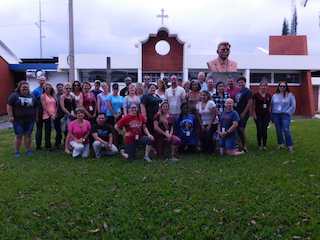Last night, shortly before we were scheduled to leave the hospital, a patient experienced serious duress in the recovery room. Every member of the medical team jumped into action . . .
After James’ devotional this morning, Mariola recounted what happened next and how it affected her:
Once they had stabilized the patient and called the ambulance, members of the team gathered around and said a prayer for the health of the young woman who was in critical condition. Mariola was deeply moved by the coordination of the many members of the medical team who worked to save the patient, and she was touched by the prayer that everyone in the room offered up as they surrounded her.
The ride home on the bus was quieter than usual as everyone thought about the patient and her family. Prayers were said, texts and Facebook messages requesting prayers were sent to families and friends back home, and thoughts revolved around hope for a good outcome.
As we arrived at Hilario Galindo this morning, we learned that the patient’s condition was improving. I hope someone tells her how many people were praying for her recovery.
Today we spent the day in the wheelchair clinic watching the wheelchair team evaluate patients’ needs and fit them with brand new wheelchairs. Patients came from small villages more than three hours away. Most of the patients were elderly, but there were also younger patients who suffered debilitating illness or injuries that affected their ability to walk.
We met Brenda, a twenty-six-year-old woman who was born with an injured spine. She had surgery as a baby, but her legs have never been fully functional. Brenda overcompensated for her weaker left leg for years, but now her right leg is injured and she’s unable to walk at all. Brenda and her family left their town and traveled over three hours in the back of a pickup truck to receive a new wheelchair. I spoke with Brenda after she received her chair and she said that she’s so happy that her mom will no longer have to lift her because she’ll be able to get around by herself.
We also met Transita who is 100 years old! Transita’s daughter, Transita, brought her to the clinic today. Señora Transita received a new wheelchair to help Señorita Transita move her around more easily. Señora Transita wasn’t feeling well today, so she didn’t say much, but Señorita Transita was very grateful for the wheelchair. (There will be a test over who received what later.)
Jon is one of the people working in the wheelchair clinic. This is Jon’s second trip with Team Morgan, but it’s far from his first mission trip. Serving people is in Jon’s blood—when the opportunity to serve arises, he jumps at the chance. Jon has already served people in Central America as a civil volunteer and as a home builder, so serving on a medical mission only seemed natural. Jon shared his thoughts about working in the wheelchair clinic this morning at devotional, and I asked him to share them here:
Yesterday the wheelchair team saw 30 clients. We gave away 26 wheelchairs, a couple of walkers and canes, and a pair of crutches. We organized the storage room and swept up a lot of dust and mouse droppings. We posed for pictures with people whose lives will be made easier and hopefully more rewarding because of their newfound mobility with their new wheelchairs.
Our team, unlike the surgical team, doesn’t have years of training and experience. We’ve watched a couple of YouTube videos and had a demonstration from Byron, our Guatemalan wheelchair expert. We don’t wear scrubs; our uniform is mosquito repellent. Our work spaces are far from sterile. A power outage is a minor inconvenience rather than a crisis.
Our clients arrive with 1, 2, 3, or more family members, packed into buses, ambulances, minivans, and cars. They spend a few hours with us and we touch each other’s lives. We communicate with the universal language of smiles, laughter, handshakes, and hugs. Then they depart, packed back into their vehicles with wheelchairs strapped to roofs, in trunks, or crammed beside them in the back of the ambulances.
The men are dressed simply, sometimes with a story behind their Los Angeles baseball cap or Louisiana State University t-shirt. The women’s skirts and blouses often match the splendor of the IRTRA peacocks.
I will always be thankful for this opportunity to make new friends on the wheelchair team, and to be involved in such an important way with these beautiful people.



